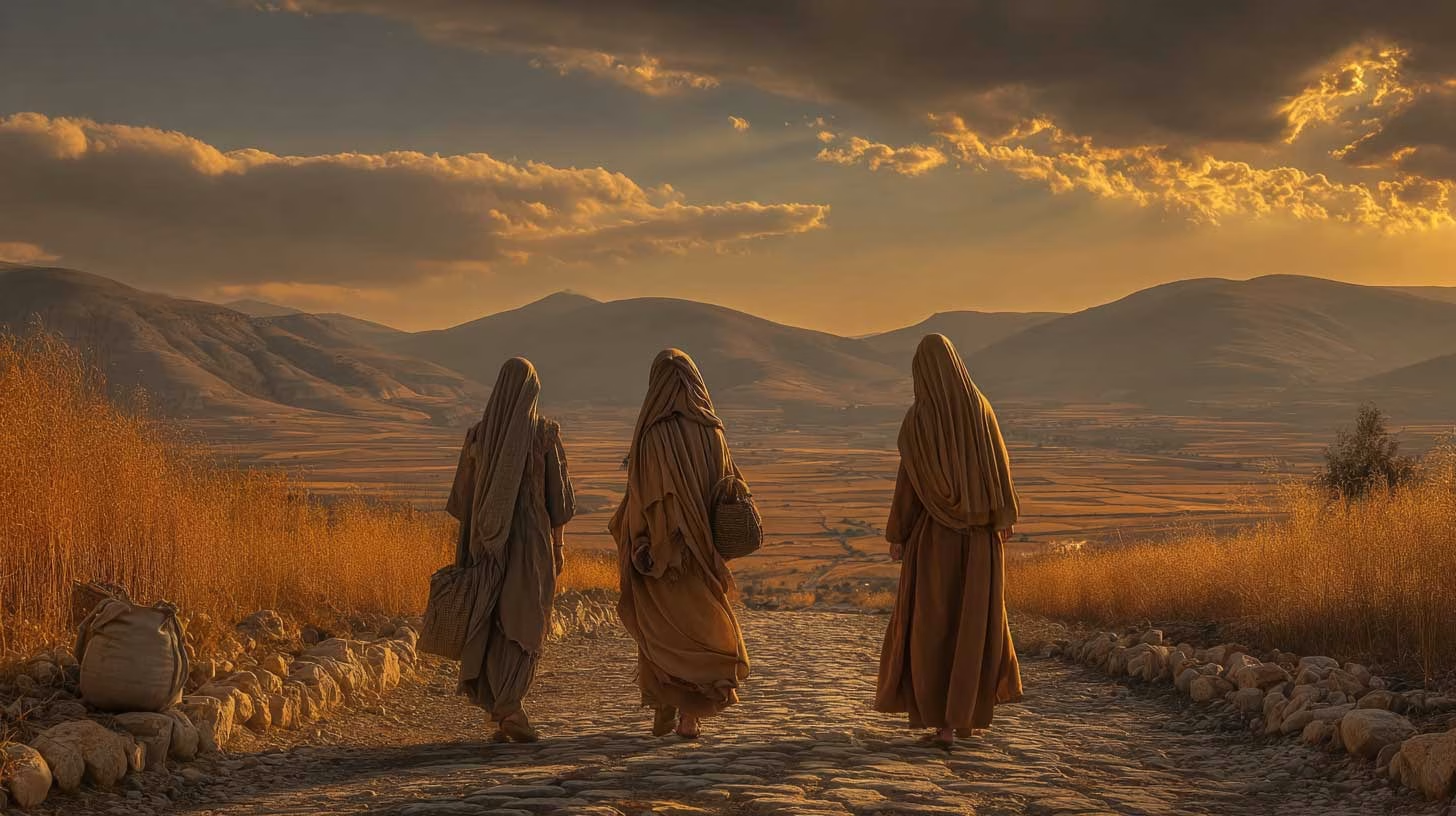
Ruth Chapter 1 shows that faith illuminated through hardship. Naomi’s bitterness and Ruth’s fierce loyalty together reveal that God’s providence often arrives amid loss, not in spite of it. This chapter teaches that return, allegiance, and quiet faith set the stage for divine restoration.
Table of Contents
The Book of Ruth Chapter 1 opens on loss, scarcity, and uncertain journey—a hauntingly familiar landscape for anyone facing today’s volatile world. In a time when families are displaced by war, communities shaken by economic hardship, and individuals gripped by loss or fear, Ruth and Naomi’s story speaks with fresh urgency. This study is for every believer seeking hope in adversity and assurance that God is working, even when His purposes seem hidden.
At Trust and Obey with Chuck Frank, we believe biblical wisdom must be applied to real life and real nations. As our mission affirms, “a Constitutional Republic can only survive and thrive with a believing populace.” Ruth’s record is not just spiritual heritage—it’s survival wisdom for individuals, families, and societies at risk of forgetting God in the storm.
Through the Book of Ruth Chapter 1, you’ll discover:
- How faith in crisis unlocks God’s hidden providence
- Why loyal love and character matter more than circumstance
- Practical ways to trust God and serve others when hope seems lost
- How biblical truths speak to both private pain and public need today

Famine and Flight: When Life Forces Hard Choices
The Crisis Begins: “In the Days When the Judges Ruled…” (Ruth 1:1)
Ruth 1 opens amid national chaos and famine—during the Lawless time of the Judges. This sets the tone: God’s faithfulness can begin in our darkest hour, and even a small act of return becomes a bold move of providence.
The Book of Ruth Chapter 1 grounds us in Israel’s darkest season—the time of the Judges, when “everyone did what was right in his own eyes” (Judges 21:25). There is famine, both physical and spiritual. Into this scarcity steps Elimelech, leading his wife Naomi and their sons from Bethlehem (the “House of Bread”) to Moab—a hostile, pagan land.
Why would a believer leave covenant territory? Sometimes, the pain of the present overpowers the pull of the promise. Surviving meant breaking tradition, risking scorn, and trusting that God could work outside the familiar. Today, families still face such gut-wrenching moves—economic emigration, seeking refuge from violence, or starting over after loss.
For related guidance on trusting God in uncertain times, visit our Bible Messages overview, and see God’s faithfulness throughout history.
Loss Compounds: The Deaths of Elimelech, Mahlon, and Chilion
The hope of new life in Moab soon crumbles—Naomi is widowed, then mourns both her sons. She is now a foreigner, a widow, and a grieving mother with two Moabite daughters-in-law (Ruth and Orpah). In ancient culture, such a loss spelled not just sorrow but destitution; without male protectors or property rights, their future teetered on ruin.
It is here—in the “desolate now”—that the Book of Ruth Chapter 1’s greatest lessons begin to unfold: God’s providence often glimmers most in the wreckage of our best-laid plans.
“Then she arose with her daughters-in-law that she might return from the country of Moab, for she had heard… that the Lord had visited His people by giving them bread.”
—Ruth 1:6
This echoes the providence discussed in God’s Providence in Esther 2, where God moves in both exile and return to fulfill His purpose.
The Great Turning: Loyal Love in the Valley of Decision
Naomi’s Hard Goodbye
As Naomi journeys toward home, she urges her daughters-in-law—Orpah and Ruth—to leave her and seek new husbands in Moab. Her logic is heartbreaking but practical in the Book of Ruth Chapter 1: without husbands, their future in Israel looks bleak. She speaks out of pain, self-blame (“the hand of the LORD has gone out against me”), and humility—her own “bitterness” leading her to believe she is unworthy of their sacrifice.
Orpah weeps, kisses Naomi, and returns. Ruth, however, will not. What compels Ruth—this foreign widow—to choose the unknown over the familiar, faith over safety?
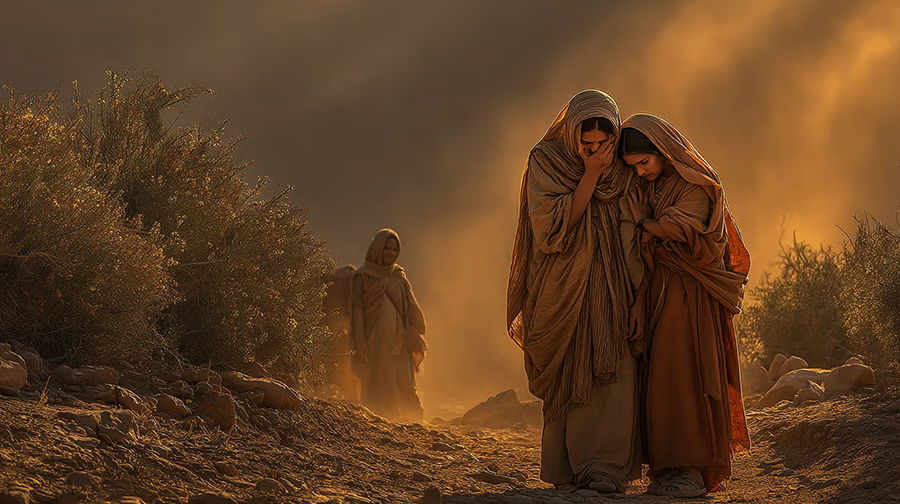
Ruth’s Famous Pledge
“Do not urge me to leave you or return from following you.
For where you go I will go, and where you lodge I will lodge.
Your people shall be my people, and your God my God.
Where you die, I will die, and there will I be buried.
The Lord do so to me, and more also, if anything but death parts you and me.”
Ruth 1:16–17
These words—often quoted at weddings, funerals, and moments of commitment—carry a force transcending time. They embody chesed (loving-kindness), the kind of covenant loyalty that transforms both individuals and nations.
For more on loyal love in difficult times, see our Five Smooth Stones scripture resources.
Trusted in the Unknown
Ruth’s decision became the hinge of history. By aligning herself with Naomi—and with “your God”—she entered the story of Israel’s redemption, embracing risk, stigma, and the unknown. Her faith would be honored by God, establishing her as ancestress to David and, ultimately, Jesus the Messiah.
Even today, faith in crisis, not comfort, is what God uses to write new chapters for His people.
Arrival, Grief, and Community: Naomi and Ruth Walk into Bethlehem
Walking into the Unknown: Return at Barley Harvest
The Book of Ruth Chapter 1 builds anticipation as Naomi and Ruth make the arduous journey from Moab to Bethlehem—a trek of at least 60 miles skirted around the Dead Sea, marked by uncertainty and fatigue. Picture two women: one aged by loss and disappointment, the other foreign and likely anxious about her future in an unfamiliar culture. The only thing they possess is each other.
As they enter Bethlehem, community eyes turn. “Is this Naomi?”—a question whispered by women who remember a prosperous family now reduced to two widows and a lifetime of pain. They have returned at the very beginning of the barley harvest, a season pregnant with the possibility of provision.
Revisit our Books of the Bible overview for deeper context of the environment Ruth and Naomi faced—a world where every harvest mattered.
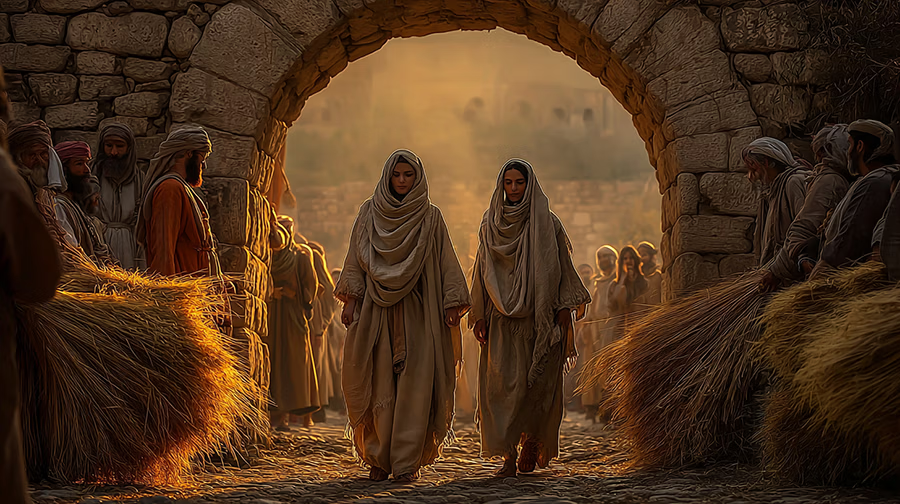
Naomi’s Lament: “Call Me Mara”
Naomi’s voice is heavy as she addresses the women of Bethlehem:
“Do not call me Naomi [pleasant]; call me Mara [bitter], for the Almighty has dealt very bitterly with me. I went out full, and the Lord has brought me home again empty.” (Ruth 1:20–21)
This confession, raw and unvarnished, reveals the depth of her sorrow. Naomi interprets her tragedy as evidence of God’s judgment. She is so consumed by her pain that she overlooks the loving loyalty standing right next to her in Ruth. The Book of Ruth Chapter 1 is not afraid to show spiritual struggle—even righteous people question God’s plan, at times unable to see the seeds of redemption just below the surface.
This is one of those places where biblical stories refuse to be fairytales. Naomi’s bitterness is not painted as rebellion but as the real, human cry of someone who feels disappointed with God.
For insights into biblical honesty and perseverance in pain, explore Proverbs Daily Meditation, where wisdom for the heartbroken is a recurring theme.
“Full to Empty”: The Illusion of Loss
Naomi believes she is entirely empty. But the narrative gently corrects her, showing that God’s provision is already at work, even if she can’t see it yet. The “beginning of barley harvest” is both a time stamp and a symbol: God is already up to something, just as He was unseen in Esther’s deliverance.
This moment is a challenge to all of us—how often do we declare ourselves empty, not noticing the Ruths walking beside us? How often do we miss God’s hidden hand because we are lost in the landscape of what’s been taken away?
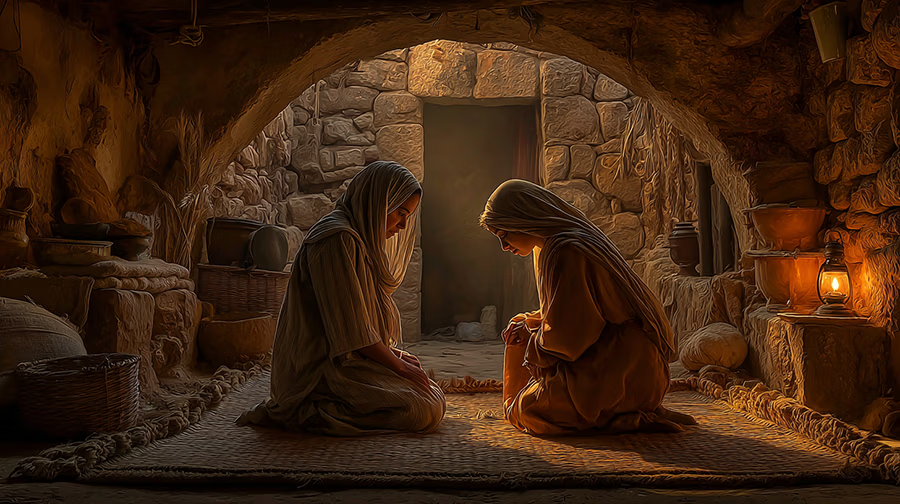
Faith Over Feeling: Trusting the Invisible God
“God Has Afflicted Me…” Or Has He?
The Book of Ruth Chapter 1 recognizes the temptation to interpret suffering as divine punishment. Naomi’s words echo Job’s lament—“Though He slay me, yet will I trust in Him.” (Job 13:15)—but where Job clings to hope, Naomi sees only the curse. The Bible, in both examples, gently subverts our expectations. Faith does not mean feeling good all the time; it means moving forward when nothing makes sense.
The story challenges us: reject the narrative that you are forever defined by your worst day. Ruth becomes a living answer to Naomi’s silent prayer—a daughter-in-law whose devotion will soon turn the tide for both.
For a dive into scriptural resilience, visit our Christian Living blog where the theme of trusting God in the darkness recurs.
Providence in the Ordinary
Even as Naomi’s faith is battered, the narrator signals to the careful reader that God’s story isn’t done. Return coincides not just with “a” harvest but with the barley harvest—a season of renewal, of first fruits, when the community will gather and share. God’s answer rarely looks like a rescue helicopter; more often, it’s a new rhythm, a field ready for gleaning, a conversation at the gate.
Naomi’s return at barley harvest hints that divine provision is often timed to our darkest hour. Nothing in the Book of Ruth Chapter 1 suggests that following God assures easy answers, but everything whispers that faithfulness puts you in the path of blessing.
For more on work, routine, and God’s quiet faithfulness, see Resources for Christian Growth and Study.
What Ruth Teaches Today’s Christian Citizens
Loving-Kindness and Civic Renewal
Ruth’s steadfastness is about more than family loyalty—it is a testimony to loving-kindness (chesed) in public life. The Book of Ruth Chapter 1 stands as a rebuke to cultures that elevate self-interest. Ruth chooses the welfare of another over her own; she crosses barriers of blood, language, and suspicion for love’s sake.
As Pastor Chuck Frank often notes, a Constitutional Republic thrives only when its people live by this kind of moral vision. Our nation’s founders once believed that the virtues of faith, hope, and love were necessary not just for individual integrity, but for the survival of liberty itself. Ruth models that “believing populace”—her faith renews a household, a village, a people.
For more on Christian civic responsibility, see our Mission statement and related commentary from our Today’s Concerns section.
Throughout American history, spiritual renewal and compassionate community have revived public life. Should Christians respond with prayer, sacrificial service, and engaged citizenship, as Ruth modeled to Naomi? Join a faith-centered fellowship to practice these ideals together.
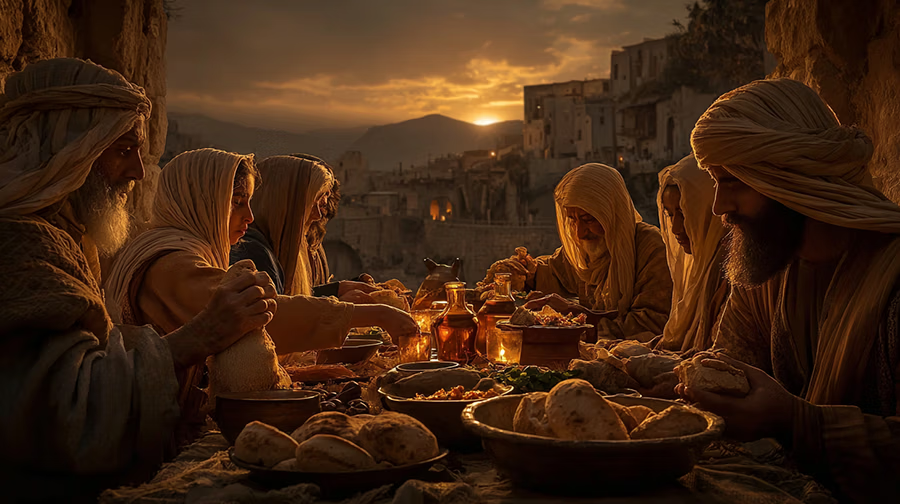
Practical Applications: Living the Lessons of the Book of Ruth Chapter 1
Personal Faithfulness—What Can I Do?
When life feels stacked against you, ground yourself in four Ruth-like actions:
- Show loyal love in your relationships. Ruth did not wait for an ideal situation—she made a vow and kept it.
- Be present for those who grieve. Like Ruth, you may be the “hidden hand” God uses for someone else’s breakthrough.
- Commit to the dailies. Small acts—gleaning, praying, serving—are fertile ground for providence.
- Anchor your identity in God, not in loss. Even if you feel like Naomi, God may be cultivating an unexpected harvest just beyond your horizon.
Explore these principles further with Our Bible Messages and all Books of the Bible studies.
Family, Community, and National Hope
If our culture feels rootless—if we long for renewal but see only emptiness—the Book of Ruth Chapter 1 urges us not to give up. God is looking for “Ruths”—individuals, families, churches—that will practice faithfulness when it’s least rewarded. Often, the first sign of God’s new work is the faint green of a barley field after drought.
Looking for modern encouragement? Cross-reference G-Dash, a collection of rapid-fire biblical truths for current challenges.

Deep Exegesis: Faith, Providence, and Divine Surprises in Ruth 1
Unpacking the Journey—From Bitterness to Breakthrough
The Book of Ruth Chapter 1, when viewed through both spiritual and practical lenses, is a blueprint for surviving and thriving in adversity. Naomi’s grief and Ruth’s loyalty do not exist in isolation; they mirror the spiritual journey of countless believers. What can we learn about real-world faith from these two women’s path?
Naomi’s Perspective:
- Naomi’s lament reflects the honest prayer of someone blindsided by loss. She cannot see the “next thing” God will do. Hers is a faith forged in the fire, raw but real.
- Yet, what Naomi deems emptiness is the beginning of fullness. Her “Mara” identity is a temporary verdict—God is not yet finished.
Ruth’s Perspective:
- Ruth embraces radical newness for love’s sake. She chooses God over comfort, perseverance over retreat.
- In making Naomi’s God her own, Ruth becomes a bridge—between peoples and destinies—demonstrating a faith that goes beyond words.
This is echoed in Books of the Bible—Scriptural Overview and Context, which challenges readers to situate their suffering inside God’s redemptive pattern rather than viewing adversity in isolation.
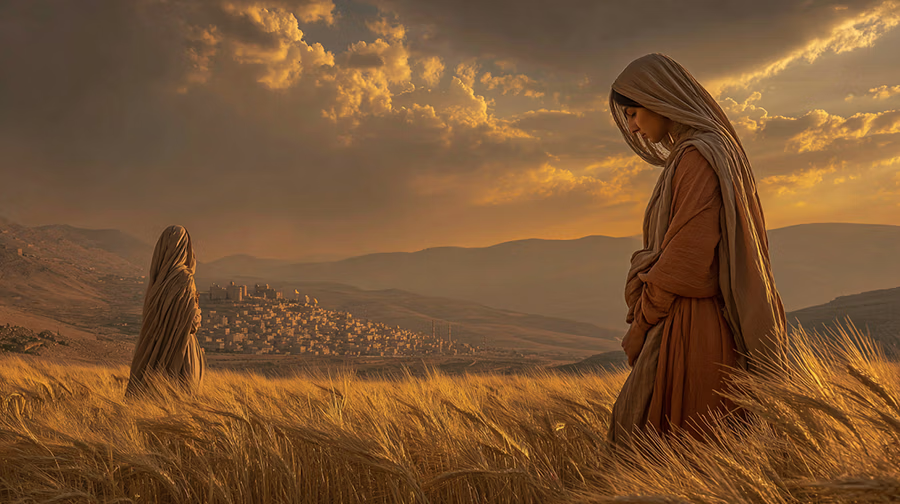
Providence Meets Personal Agency
The Book of Ruth Chapter 1 is a masterclass in the interplay between God’s sovereignty and human action. God provides space and season (barley harvest), but Ruth must walk into the field. God opens opportunity, but our steps, prayers, and acts of loyalty serve as the vessel.
Everyday acts of faithfulness—prayer, welcoming a stranger, serving a grieving friend—become vehicles of providence. This is as true for modern believers as it was for the Moabite widow.
For resources on finding God’s purpose in daily tasks, browse Resources—Tools for Christian Growth and Study.
Ruth for the Church, the Nation, and the World
Loving-kindness as Light in Civic Darkness
Why does the Book of Ruth Chapter 1 matter for the church and society? Because it illustrates the kind of self-giving, compassionate, truth-rooted citizenship necessary for a nation’s renewal. If our communities are to recover from cynicism, injustice, or division, we need more Ruths—people committed to God’s truth, their neighbor’s good, and the courage to bridge divides.
Chuck Frank’s reflections in Today’s Concerns offer further application: it is not enough to wish for renewal; one must act with steadfastness, love, and sacrificial engagement.
The Power of One: Ruth’s Legacy in World History
Ruth may have felt her actions were small—going with Naomi, gleaning barley, choosing a faith not her own. Yet her steps became the foundation for King David and, ultimately, the Messiah. The Book of Ruth Chapter 1 insists: your fidelity, even uncelebrated today, can shape communities, economies, and salvation stories tomorrow.
Look for more about personal and national restoration in the Mission section, connecting faith to liberty’s future.

Practical Steps: Applying Ruth 1 to Personal and Public Life
What Do We Do with Tragedy?
Believers can draw actionable lessons from Ruth and Naomi’s story:
- Embrace honest lament—but do not allow it to define your identity.
Naomi’s transparency before God is sacred, but by the end of the book, she reclaims her true name and future. - Choose faithful presence over comfort-seeking withdrawal.
Ruth’s refusal to abandon Naomi—even when urged to—shows that breakthrough often comes through steadfast commitment. - Step into the “fields.”
Even before the blessing is visible, position yourself to receive what God may provide—through service, study, or simply showing up.
Would you like further advice for when faith wavers? Try our G-Riff reflections for meditations on scripture and contemporary struggle.
Hope Beyond Your Horizon
Harvard’s motto once read Veritas Christo et Ecclesiae—truth for Christ and the Church. Ruth 1 reminds us: real faithfulness impacts both worship and the world. In families, churches, and nations, “barley harvests” await those who trust, obey, and love well in famine.
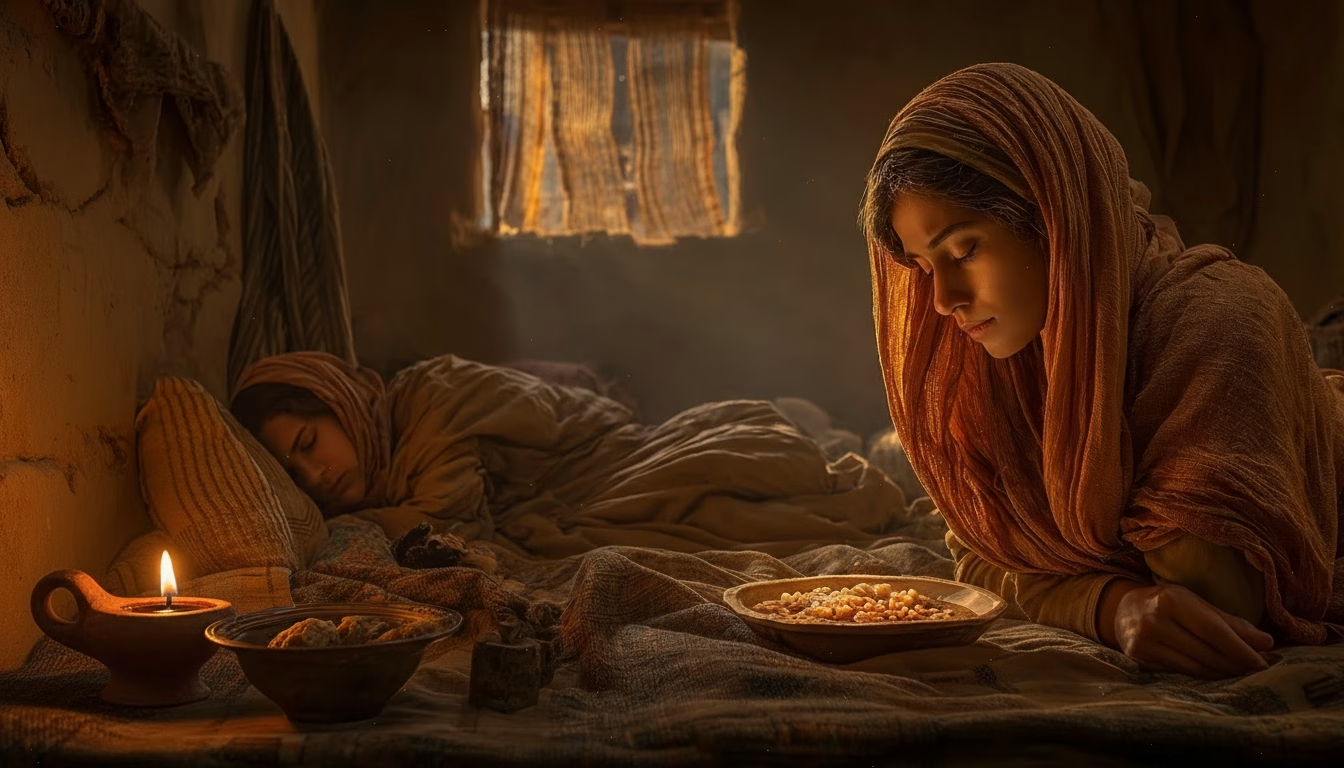
Closing Stories: Modern Echoes of Ruth’s Faith
Real Stories—Contemporary Ruths
Across centuries, countless believers have walked paths similar to Ruth:
- A refugee mother, fleeing war, finds a home in a church community who loves like Ruth.
- A widower, broken by loss, is given hope by a friend who simply refuses to leave.
- A business closes, prosperity dries up, but a believer continues to tithe, serve, and pray, trusting God’s unseen harvest will come.
Share your own “Book of Ruth Chapter 1” story in our Christian Community fellowship. How has your faith (or someone else’s steadfastness) carried you through hardship?
Reflection: “At the Beginning of Barley Harvest”
“So Naomi returned, and Ruth the Moabite her daughter-in-law with her… and they came to Bethlehem at the beginning of barley harvest.” (Ruth 1:22)
This quiet ending is a beginning. It is the uncelebrated return, the almost overlooked arrival, that sets the stage for all that follows. Naomi’s bitterness, Ruth’s courage, God’s timing—all converge at harvest.
Every one of us faces chapters like Ruth 1. What makes the difference is not the absence of suffering, but the presence of hope: God provides, God is at work, and faithfulness puts us in line to receive tomorrow’s blessing.
Explore further in Bible Messages and Book of Esther studies.

Frequently Asked Questions (FAQs)
Why does Naomi want Ruth and Orpah to return to Moab?
Naomi, out of grief and pragmatism, believes she has nothing left to offer and worries for their welfare as widows in a foreign land.
Why is Ruth’s promise to Naomi so important?
Ruth’s declaration is a vow of love that changes history—modeling for Christians what self-sacrificing, covenant loyalty looks like. Her resolution brings personal and redemptive transformation.
Is it wrong to feel bitter like Naomi?
Honest prayer includes lament. Naomi’s story teaches that bitterness is not the end of faith’s journey—God can meet us in our lament and turn mourning to dancing in His time. For more on praying through pain, see Text GOD—Confidential Prayer & Encouragement via SMS.
How can I see God’s providence when life feels empty?
Anchor to community, immerse in scripture, and trust God is always planting seeds for a future harvest—often where least expected.
Further Reading
- Book of Ruth Study Guide — BibleProject’s illustrated explanation, historical context, and literary insights.
- A Literary Analysis of the Book of Ruth — A comprehensive breakdown of genre, structure, and interpretation.
- The Book of Ruth Reveals God’s Presence in Our Work — Practical applications for faith in daily life.
- Ruth & Naomi—Application — The Moody Church’s guide to living Ruth’s lessons.
- The Global Message of Ruth — ESV’s study on Ruth’s impact for the whole world.

